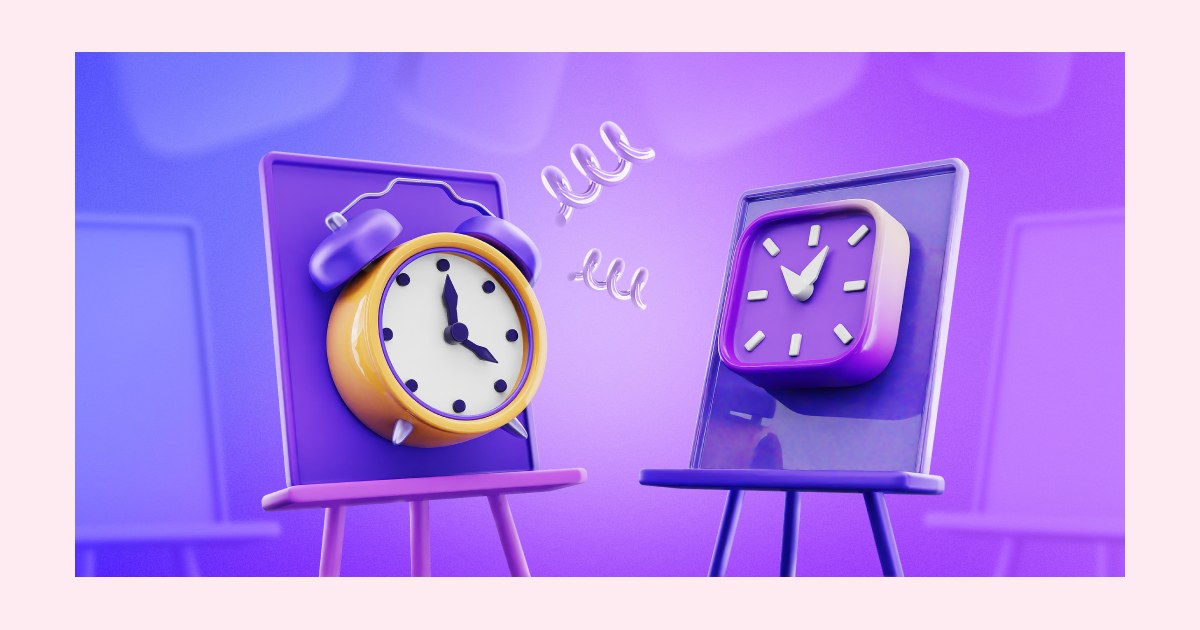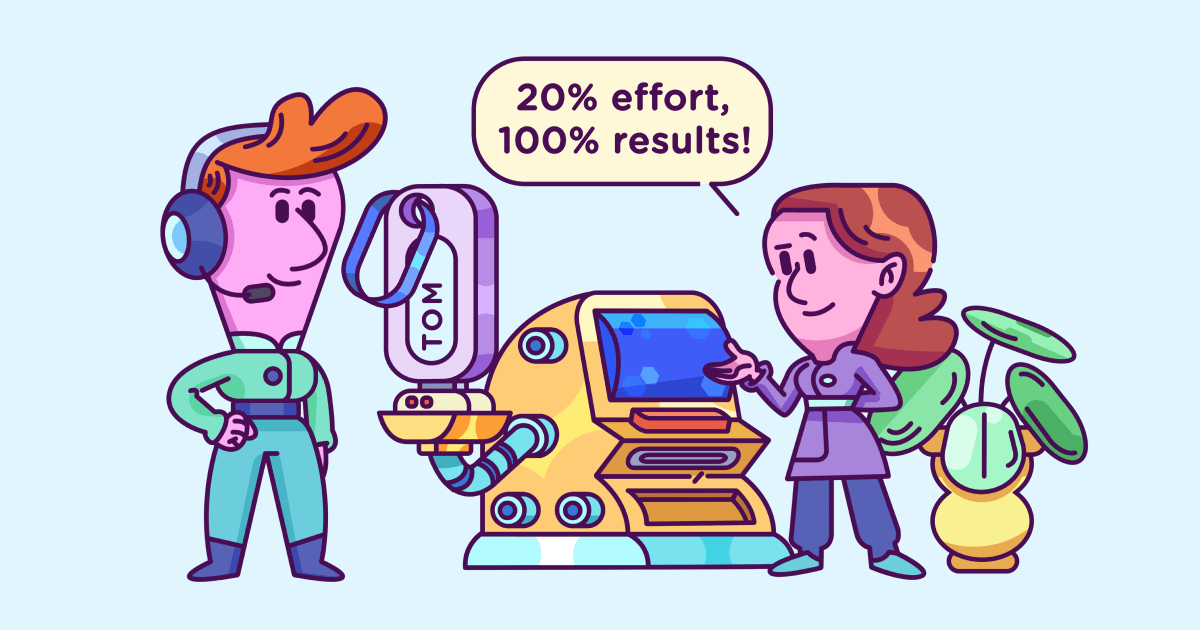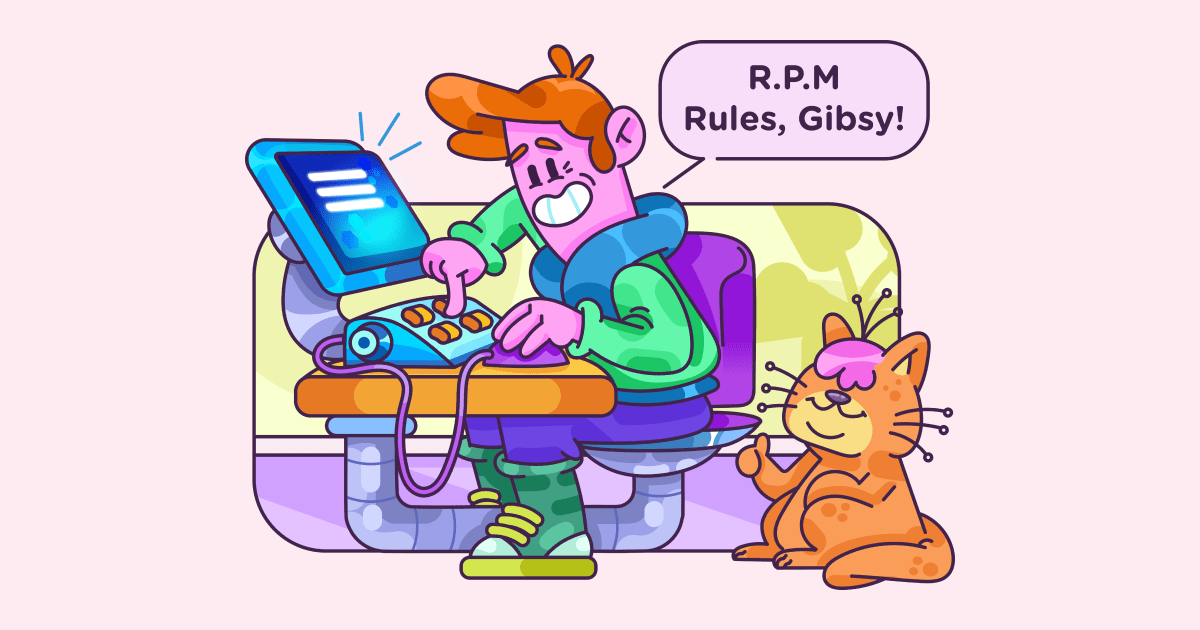How I calculated my biological prime time
Last updated on: September 2, 2022
If you’ve ever tried some productivity tips, techniques, or methods that were supposed to be life-changing and ended up being disappointed, no worries — it’s not about you.
When it comes to understanding productivity levels, the starting point is accepting the fact that each person is different.
The thing is — our energy levels depend on our personalized internal clocks, so there simply can’t be a one-size-fits-all solution.
However, there is a solution to planning your activities in accordance with your internal clock.
Let me introduce you to the concept of biological prime time and the benefits of calculating it.
I did a 3-week experiment tracking my prime hours during the day to try and calculate my biological prime time. I’ll show you how to do it yourself and share what I have learned in the process.
Well, let’s dive right in.

Table of Contents
What is biological prime time?
Your biological prime time is the time of the day when you have the greatest amount of energy.
That means your prime time is the time when you are the most productive in accomplishing your tasks or have the greatest potential to be productive.
The author Sam Carpenter described the biological prime time method in his book Work the System. According to Carpenter, the gist of the method is to work smart, instead of hard, and the method is aimed at boosting self-development.
This book was originally published in 2008. In the meantime, the term gained popularity, as well as new layers and depths of meaning, especially in psychology.
Another notion important for understanding biological prime time is the Circadian rhythm — the physical, mental, and behavioral changes we undergo within 24 hours.
Our minds and our bodies go through various stages during that period, so it is crucial to learn how our specific internal clocks function — in order to be the best version of ourselves.
Why I decided to calculate my biological prime time
There are two types of people in the world — morning larks and night owls.
There’s no doubt I fit into the latter category. My whole life, I’ve been struggling with getting up early or not snoozing the alarm. I’ve never enjoyed having to do important tasks in the morning.
For example, if I had to take an exam before 9 a.m., I’d often sleep in the evening and then stay up the whole night. With a little help from my power naps, it all seemed to work out fine at the end of the day.
But, then I got my first real job, and it included early morning meetings. Some other adult responsibilities came along as well — I had to occasionally visit the bank or run an errand before work, as after my work hours, these facilities would be closed.
Bear in mind, I’m not saying I couldn’t do it — it was more about lacking the energy and motivation to do it. At such moments, coffee was my best friend.
Even though I could always adapt to the circumstances, the truth is — I’m simply not a morning person and will never be. But, once I started tracking my internal clock, I started realizing — it’s much more complex than that.
I’ve also checked with multiple morning larks — turns out, it works the same the other way around. Just as getting up early is a form of torture for me, staying up late is a nightmare for my morning lark friends and colleagues.
But the good news is there is a hack to it all — figuring your biological prime time allows you to work on your own clock by understanding your peak hours. That’s why I decided to try this technique.
4 Steps to calculating your biological prime time
The first thing you have to know about calculating your biological prime time is that you must commit to this experiment for at least 3 weeks. I’ll explain why in a bit.
The second thing is — calculating your biological prime time likely won’t be a problem, because it is as fun as it is beneficial.
Finally, your prime time is something that you already instinctively know and feel — you just need to add the tracking and charting part.
Okay, so what’s the practical part? Here’s how to calculate your prime time:
- Track your time spent on different tasks,
- Track your energy levels during the day,
- Track your motivation, and
- Track your productivity.
This is the method I used to track my biological prime time.
Most of us have an already developed routine and specific tasks we ought to complete on a daily, weekly, or monthly basis.
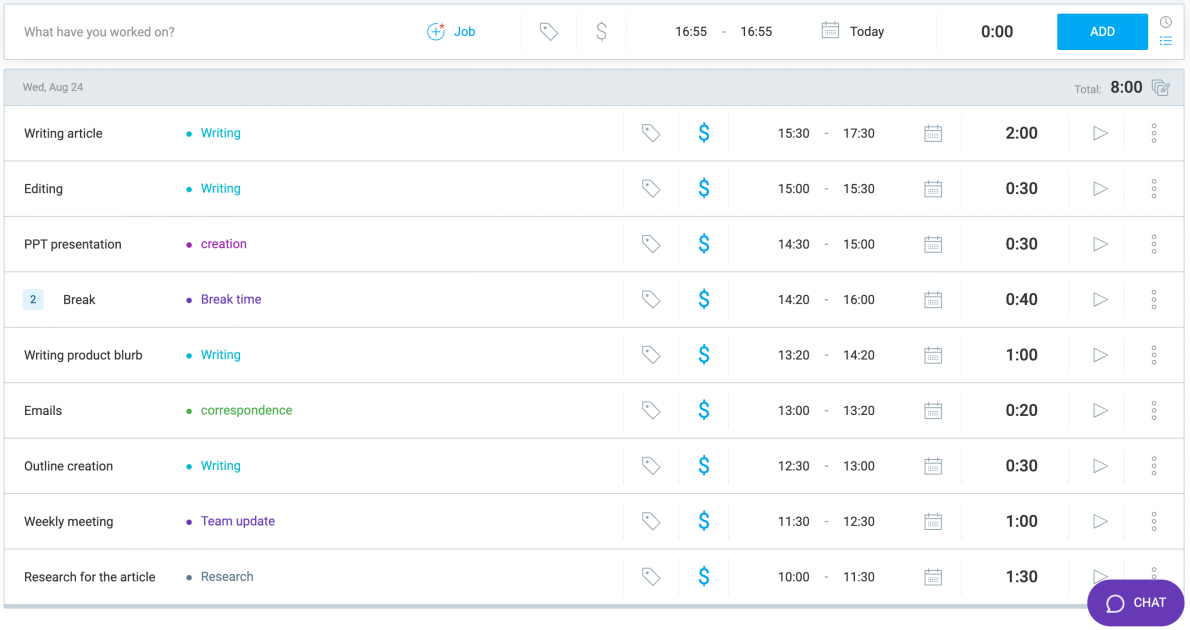
Here’s what my typical routine looks like, in terms of a workday. As you can see, I usually get most of my tasks done after 12 p.m. Also, you may notice that I always make room for a small break, and a lunch break, to maintain productivity.
However, having a steady routine doesn’t mean that there’s no room for improvement — you can trust me on this one.
Or even better, don’t take my word for it — check it out yourself instead.
Daily tracking is an amazing way to compare your performance levels in different parts of the day.
But, just remember this — it’s all about finding the right part of the day to complete a specific task. And, by “right”, I mean — right for you specifically.
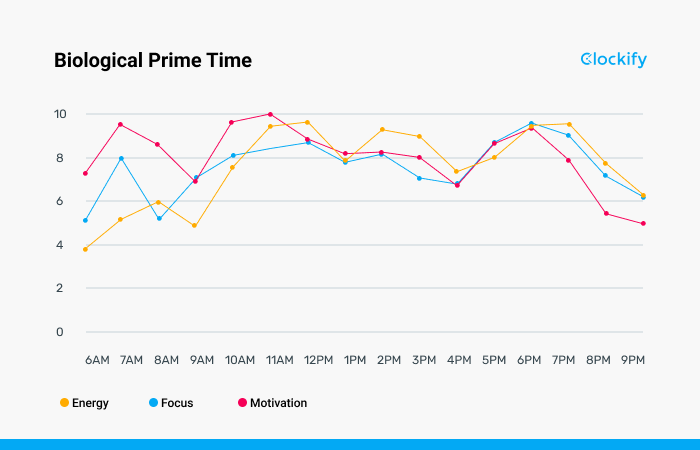
How I tracked and calculated my biological prime time
So, I time tracked my activities and charted the 3 above-mentioned levels over the period of 3 weeks.
For hassle-free time tracking, I used the time tracking software Clockify.
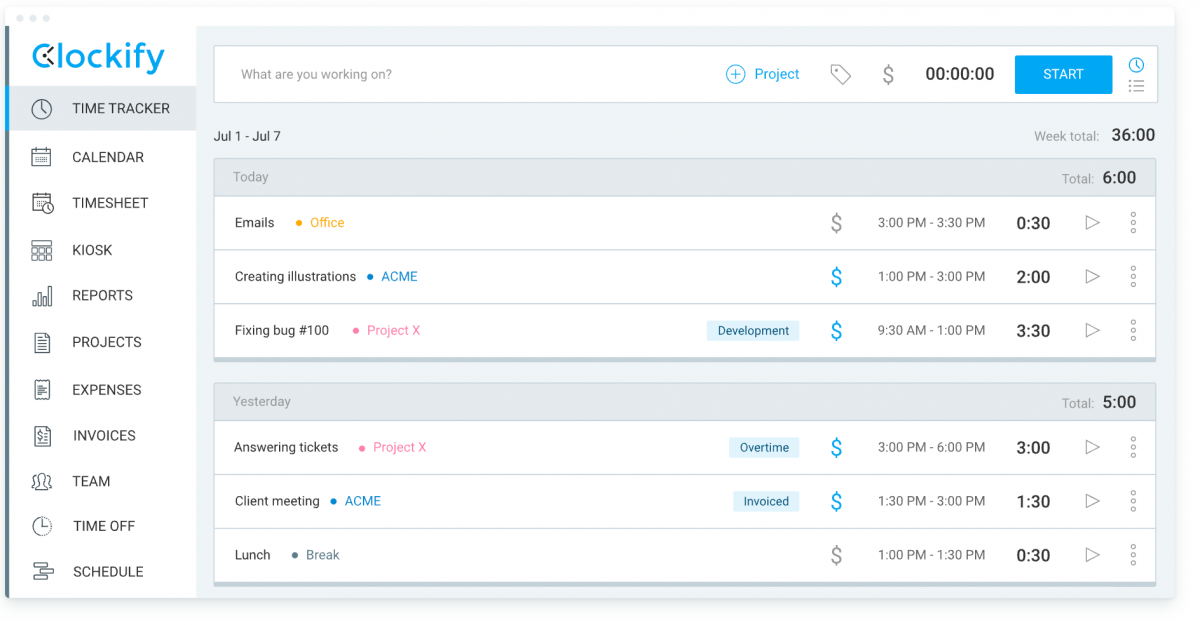
In Clockify, you can either manually enter the time in your timesheet after completing a task, or track it in real-time using the Clockify timer — whatever option works better for you.
Clockify’s calendar view will help you:
- Visualize your schedule,
- Customize it in a better way, and
- Compare how much time you’ve dedicated to each task in different parts of the day.
As for charting my energy, motivation, and productivity levels — I simply used Google Sheets. If you have any other solution in mind, a planner or something else, that will also do the job.
What matters is that you record your levels on a 1 to 10 scale.
The ease with which you’ll be able to collect the data will help you get the most precise results.
How charting my biological prime time looked like
Once I picked the tools that will help me define my biological prime time, I created a simple division to differentiate between the:
- Morning,
- Early afternoon,
- Late afternoon,
- Early evening,
- Late evening, and
- Night.
It is important to mention that you must dedicate specific hours to these sections of the day to be able to combine the data with the following step — charting your hourly levels of energy, motivation, and productivity.
For example, morning for me usually starts around 9 a.m., but I know a lot of people whose mornings start at 7 a.m. or even earlier.
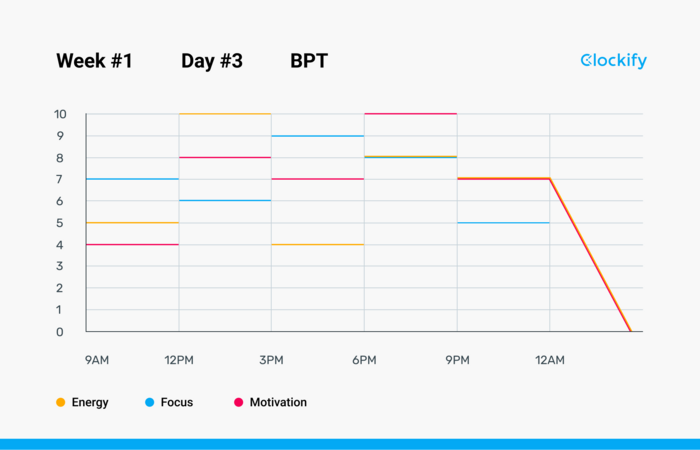
You can see my example from the third day of this experiment in the picture above. Some of the results didn’t make sense to me — but it was due to this being the first week.
Here are several things that I found really interesting:
- My focus was the highest when my energy was at its lowest point,
- My motivation was the highest between 6 p.m. and 9 p.m. (probably typical for a night owl, but still a little later than usual for me), and
- My focus in the morning was higher than I expected.
As I’ve mentioned, I tracked all this for 3 weeks. But there’s a catch — each week has a specific function. During the first week, I had to avoid any stimulants, including caffeine.
So don’t worry if you find yourself in a similar situation, it’s just your body adapting to a little different lifestyle.
Now let’s get into more detail about each week and its functions.
Week #1 Learning how you function without any stimulants
As I’ve already mentioned, there are parts of the day when coffee is my best friend. However, all stimulants, boosters, and depressants can significantly impact our internal clocks.
Consequently, I had to say goodbye to all such products in week 1 to understand my natural energy levels.
This means that, during the first week, you ought to learn a thing or two about how your energy levels vary without any caffeine, alcohol, or any other stimulants.
For best results, you should try to have a balanced and healthy diet, eat regularly, and stay properly hydrated.
After all, the latest productivity statistics indicate that adequate nutrition by itself boosts productivity levels by a stunning 25% — so you must pay attention to this as well.
I know life can be hectic, but, if you tend to skip a meal or not drink enough water — set a reminder.
This is the only way to start noticing your actual, natural energy levels.
Observations during week #1
So, I must admit — during the first couple of days, I found myself being actually nervous and more agitated than I usually am.
This was most likely due to the abrupt caffeine intake cutback.
One of the most important things I’ve learned about caffeine is that it was much more about the ritual itself than it was about the direct effect of caffeine on my body. So, when I switched to making myself a nice cup of tea instead, my brain soon started perceiving it in almost the same way as coffee.
Since I was caffeine-free, I noticed some changes in the 3 levels I was tracking. As I mentioned after my example, if you’re also passionate about coffee, sometimes those levels will abruptly change during the day, as your body is adapting.
My energy levels suddenly started rotating between peaks and dips, as I didn’t have my favorite booster. After 9 p.m., I noticed both my focus and motivation were significantly lower than before the experiment.
Also, I realized how high my focus was in the morning, which I’d never noticed before, most likely because I would be focused on my lack of energy. And right after 12 p.m., I would have a sudden drop in my focus, while my energy would reach its peak.
Interestingly, during the first week, my motivation would reach the highest point and a score of 10 only after 6 p.m., along with my focus and energy, who’d both score an 8.
Having no stimulants also meant going to bed earlier, so even though I rarely finish my day before 2 a.m., during this week, I’d have sudden drops in all 3 levels and fall asleep before 1 a.m. (one day even before midnight.)
Week #2 Let your natural rhythm define you
So, when you’ve spent a full week without caffeine and other stimulants, you need to pay attention to how your mind and body work.
At this point, you’ll start noticing how your physical, mental, and behavioral changes differ, compared to the days when you’ve “corrupted” your organism with stimulants or depressants.
And, this week, it’s all about understanding what comes naturally to you.
Let me explain what I mean by this and provide a couple of examples.
First things first — how much sleep is optimal for your best performance during the day?
Here are some ideas that I’ve tried, and suggest you do too:
- Try not setting an alarm clock,
- Take a midday nap if you feel like it,
- Don’t use any electronic devices at least 2 hours before your bedtime (but for real).
The whole point is to just try to fall asleep and wake up naturally, to monitor and answer the following questions:
- How much sleep is ideal for your cognitive and physical performance to be optimal?
- What is your ideal sleep schedule?
You may be surprised, as I was, by what you find out. For example, I realized I was oversleeping, even though I was only trying to follow experts’ advice and have a good night’s sleep of 8 hours whenever I can.
Even though I am a night owl, life without coffee resulted in getting to bed earlier.
So, by the end of the second week — it turned out that I can wake up completely naturally after 6.5 hours only. That said, for me, this also means having a power nap sometimes in the afternoon is a must.
Here’s what else I discovered during the second week of my experiment.
Observations during week #2
I’ve already mentioned the morning I woke up naturally, with less than 8 hours of sleep — I was stunned by how good I felt that day.
I was also feeling:
- Completely fresh and clear-minded,
- Actually proud of myself, and
- Quite happy and energized.
That’s when I knew I was really on the right track.
I found out that being a night owl doesn’t mean my energy peaks only after 2 p.m. (something I’ve previously been convinced about), but rather that I have several energy peaks during the day.
So, for me, the peaks happen around:
- 11 a.m.,
- 2 p.m.,
- 7 p.m., and occasionally even
- 10 p.m.
So, believe it or not, understanding when my brain is operating at its peak performance has helped me break a prejudice I had about myself.
Week #3 Start logging your energy levels every hour
In the third week, you will have already clearly noticed some benefits, and your mind will be clearer.
That’s the perfect time to step up the game and start logging your energy, motivation, and focus levels every single hour you’re awake.
That’s exactly what I did, for each hour of the day.
Here’s an example of my 4th day in week three.
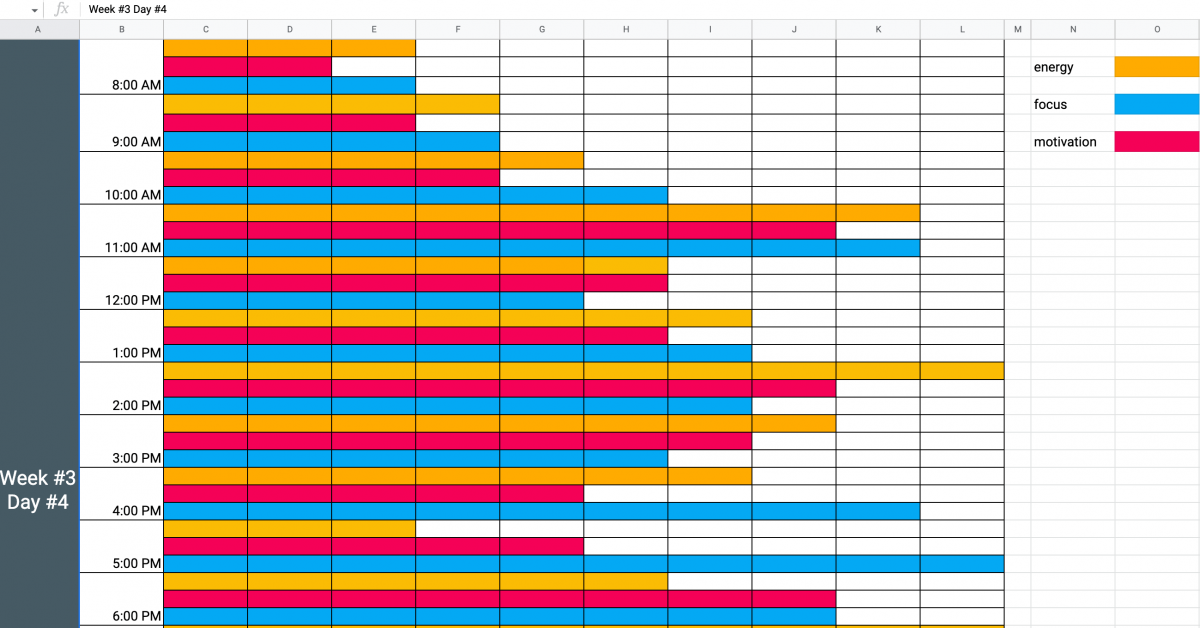
Your chart will basically look the same, including your energy, focus, and motivation on a 1 to 10 scale. However, gathering more data will ensure that you are actually identifying your peak hours accurately and precisely to the hour, instead of only for different sections of the day.
Additionally, at this point, you’re already a pro at tracking your productivity levels, you’ve developed some healthy habits, and I swear — you’ll want to continue improving.
To boost your motivation to do the same, I’m sharing a variation of the template I’ve created and used — you can download and use it yourself.
🔽 Template for tracking your biological prime time
Observations during week #3
At this point, I was actually eager to step up my game. I wanted to get to know the exact equation that will solve all my problems.
The truth is — there is no such thing as a perfect equation, and the levels can vary based on external factors as well, such as bad weather.
I finally understood that being a night owl doesn’t necessarily mean I can’t be productive during the first part of the day. Once I separated the 3 categories, I realized that even when my energy is low, my focus can be at its peak.
Usually, if my energy was low, I would opt for a break, or do a low-priority task. Finding out when my focus is really high at the same time has shifted my perception of such periods. I tried completing some of the most important tasks during these times, and guess what? I accomplished those tasks more efficiently and in less time.
Once again, I was stunned. I couldn’t believe I was wasting all that high-focus time on my breaks, or doing chores.
The one thing that was definitely clear during week 3 was — I had completely understood tracking these 3 weeks will be only a part of the process of self-improvement. I can clearly remember the moment when it all started to fall into place, and truly make sense.
I can’t emphasize it enough — try it out and let your own jigsaw fall into place. The “sacrifices” are — and this is an understatement — completely worth it.
Benefits of identifying your biological prime time
Once we are fully aware of our own physical, mental, and behavioral changes throughout the day, we get to improve our overall productivity.
That’s because we can then schedule our most important and high-leverage activities and tasks for our peak productivity hours — i.e. our biological prime time.
Here are the 3 crucial benefits I’ve noticed after calculating my biological prime time.
#1: Increased productivity
Your daily productivity levels are directly related to the quality of your life, especially in regard to work-life balance. People are not meant to be productive all the time, and it is perfectly fine that we’re sometimes struggling with our tasks, even the simple ones.
Finding your prime time means identifying energy peaks in your day and, moreover, using those peaks to get the most important work done resulting in high productivity.
Outside your peak hours, when you’re not feeling as energized, you can do smaller, mundane, and routine tasks that don’t require high focus.
Furthermore, you can schedule your breaks for periods of energy dips.
💡 Clockify pro tip
Want to find out more ways to improve your productivity levels? Check out this guide:
#2: Higher motivation
Once you’ve identified said peaks, you will be able to improve your daily routine. Being properly motivated to achieve your goals can make all the difference.
Having the motivation to do something is closely tied with better focus when performing a task, so, apart from being more productive, you’ll also be more efficient.
There are 2 main types of motivation — intrinsic and extrinsic — and by finding your biological prime time, you will be able to increase both.
Intrinsic motivation is related to our internal satisfaction — engagement in an activity or behavior because we find it rewarding. So, once you are more productive and know how to adequately schedule all your daily activities, this type of motivation inspires you to complete said activities.
On the other hand, extrinsic motivation is when you are motivated to engage in an activity or behavior because of an external reward, or because you want to avoid punishment. Once you align your prime time with your most important activities, the results will be visible.
For example, you’ll perform better at work and have an easier time getting the housework done.
💡 Clockify pro tip
If you’re interested in learning more about motivation, check out our in-depth guide on the topic:
#3: Better self-image
I’m pretty sure we all know the awful feeling when you catch yourself procrastinating — avoiding certain tasks you find unpleasant, scrolling through social media feeds when you’re supposed to be working, etc. These (in)actions can lead to developing a negative self-image, feelings of unworthiness, and overall, lower self-esteem.
The good news is — it works the same way the other way around.
Productive, positive, constructive, and confident actions and behavior lead to satisfying results, improved mental health, and higher self-esteem.
Therefore, by improving your overall performance, finding your biological prime time also improves your self-esteem.
💡 Clockify pro tip
If you’ve ever struggled with procrastination and want to find a solution, this guide is a must-read:
Additional tips and tricks for making the most of your peak time
I want to share some additional tips and tricks I’ve picked up during the course of these 3 weeks.
It goes without saying that you won’t always be able to use them — but still, have them in mind and try them out if or whenever you can.
For me, all these worked and gave me an additional nudge in the right direction.
Tip #1 Tune out distractions
This one is quite easy, and I think it really makes sense:
- Set all your notifications on mute,
- Don’t check your social media — at least not during peak hours,
- Put your phone on silent mode whenever you want to focus and engage in deep work,
- Use noise-canceling headphones while working, and
- If you live with anyone and work remotely, try to find another space for these 3 weeks, or set strict boundaries (no interruptions at all) during work hours.
I understand that sometimes, you won’t be able to apply these anti-distraction tips, but you should try to do so as often as you can. And, as you can notice from the list above, I’m suggesting you should focus on this set of tips and tricks primarily during working hours.
However, this is all extremely beneficial for your time spent on your personal activities as well, such as:
- Chores,
- Exercising, and even
- Spending quality time with your friends and family (you can, however, forgo the noise-canceling headphones, obviously).
Tip #2 Find what gives you a natural boost
Coffee is not the only thing that can boost your energy. The release of endorphins, adrenaline, and dopamine can be triggered in many different ways that are completely natural.
The first thing I have to mention here is that I was one of those people who would skip a meal occasionally. Well, what I later realized was that it was mostly because of my previous caffeine intake, which would trick my body into thinking I’m not hungry.
Additionally, you’ll need to pay special attention to which foods are the best for you during the day, as your glucose and fat levels after a meal can dictate your energy levels as well.
You should especially avoid blood sugar spikes because they are commonly followed by an energy crash.
And finally, the golden rule — stay hydrated.
Here are some other useful tricks that I’ve discovered work best during the 3 weeks of this experiment:
- Mid-day power naps,
- Mid-day exercise, which can be a simple walk,
- Regular social interactions,
- Adequately addressing my stress levels, and
- Regular magnesium intake.
Again, this can all be highly personalized, and you can remove or add anything to the list above.
Tip #3 Find appropriate tasks for your downtime
As I’ve already mentioned, don’t beat yourself up when you feel your energy is lower than usual. Such downtime and energy slumps happen to everyone, and there are 2 main approaches to dealing with this common issue.
The first approach is simply scheduling your breaks during such periods.
However, sometimes, the downtime will happen during your obligatory working hours — so you’ll have to find another way to beat that slump (that is not caffeine or sugar).
The solution lies in finding the right tasks for your downtime.
Such tasks can be any in the following categories:
- The ones you enjoy doing the most,
- Routine and mundane tasks that don’t require much energy, or
- The ones that require movement.
These types of tasks are easier to do, so they will require a lot less energy.
Tip #4 Be in sync with your peaks and dips
This is probably the most important goal you can set for yourself, as it is related to everything we have said above.
That’s why you ought to create a clear plan, and, once you’ve established some patterns in your schedule — stick to them.
Of course, it will be desirable to continue tracking your time and charting your energy, motivation, and focus levels after finding your prime time. After all, during these 3 weeks, you’ll understand that it is really of the essence.
Wrapping it up: Finding your biological prime time is a game-changer
Finding your biological prime time is of utmost importance for all who want to improve their productivity and learn to structure their day in a way that works best for them.
Once you learn when your energy, focus, and motivation are at their highest, there’s no doubt you will achieve better results in every aspect of your life.
There are many details that I’m now aware of about my routine and my internal clock that help me be much more productive during the day.
And, of course, one of the most important factors in calculating my prime time and developing self-awareness was time tracking my days.
What I’ve learned is that proper time management is proper energy management as well. During these 3 weeks, planning tasks according to my biological prime time definitely replaced coffee and became my best friend at work.
✉️ Have you discovered your biological prime time? If you have any other tips and tricks, or perhaps some additional thoughts on the topic, feel free to share your thoughts with us. Write to us at blogfeedback@clockify.me, and you’ll get a chance to be featured in this or one of our future articles. And, if you liked this post and found it useful, share it with someone you think would benefit from it.

